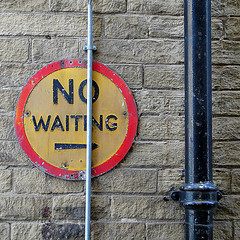The daily Scrum meeting, also known as the daily  stand-up, is the daily meeting where your software development team gathers to provide project status updates about what has been done, what needs to be done, and where there are issues. In theory, these meetings are supposed to help the team communicate and produce a better product, but unfortunately they often go wrong. People get off of topic, distracted, and, next thing you know, what should have taken 15 minutes has now taken an hour. You don’t have to worry about your Scrum meeting getting this out of hand though if you follow our advice on how to run an effective Scrum meeting.
stand-up, is the daily meeting where your software development team gathers to provide project status updates about what has been done, what needs to be done, and where there are issues. In theory, these meetings are supposed to help the team communicate and produce a better product, but unfortunately they often go wrong. People get off of topic, distracted, and, next thing you know, what should have taken 15 minutes has now taken an hour. You don’t have to worry about your Scrum meeting getting this out of hand though if you follow our advice on how to run an effective Scrum meeting.
11 Tips for Running An Effective Scrum Meeting
1. Keep the meetings on target
The first step towards an effective Scrum meeting is making sure that the meeting stays on target. In order to do this, the only subjects that should come up during this time are what each individual team member is working on as well as the issues they’re struggling with.
In order to get this information across, many suggest that each team members stick to answering these three questions, and only these questions, during the daily Scrum.
1. What did you do since the last meeting? Team members comment on whether or not their commitments from the previous day were met.
2. What will you do today? Team members explain what they’re working on today and will have done by the daily stand-up tomorrow.
3. What issues do you have? Team members explain where they are running into trouble with certain aspects of the project.
Your team should answer each of these questions when it is their turn, and they should do so without your prompting. If they do miss one of the questions, make sure you get an answer before moving on to the next person. Only by answering all three questions will the team have a true understanding of what everyone is doing.
2. Meetings should not be about problem solving
One important thing to note is that for the daily Scrum meetings to be effective, problems can’t be solved during the meetings. While the third question brings issues to the forefront, these issues may not affect the whole team. As a result, spending an excessive amount of time discussing these issues with everyone is not a productive use of team time. Call “parking lot” and table the issues for the time being. After the daily stand-up, schedule a problem-solving meeting with the individuals who these issue effect. Such an approach will allow for targeted issue resolution.
3. Team members should be prepared ahead of time
As mentioned in the discussion of the three questions, your team members should be able to answer those questions without your prompting. In order for this to happen, you must outline what you expect to hear from your team every day. Once you set those expectations, your team members should come prepared with answers on a daily basis. Reward those who do, and take aside those who don’t. Explain how being prepared with these answers helps the team, and ultimately the project, stay on track.
4. Make the meetings short
Daily Scrums that run too long aren’t effective. People get distracted, stop listening, and ramble on for far too long. Your team then begins to resent these meetings, and communication breaks down. That’s why limiting your meeting time is so important. The shorter they are, the more likely people are to pay attention and find them necessary.
For an effective meeting, the daily stand-up should run about 15 minutes. Some use the formula of 2n + 5 minutes where n is the number of individuals on your team. Either way, by sticking to the 3-question rule, your team will get all the information they need within these time restrictions.
5. Stand Up Meetings
Some believe that, by forcing everyone to stand during the daily Scrum meeting, the meeting is more likely to stay on target and on time. And let’s be honest, the reasoning is solid. No one wants to stand around for an hour just talking.
By asking your team to stand, you’re showing a commitment to staying on task, and your meetings are more likely to be effective because of it.
6. Don’t wait for everyone
 Did you say that the Scrum meeting started at 8:30? Then start it at 8:30. If you wait for everyone to show up, you’re wasting time and the meeting automatically becomes less effective. Start the meeting when you said it would begin, and allow people to trickle in.
Did you say that the Scrum meeting started at 8:30? Then start it at 8:30. If you wait for everyone to show up, you’re wasting time and the meeting automatically becomes less effective. Start the meeting when you said it would begin, and allow people to trickle in.
This doesn’t mean that you should allow people to get away with showing up late though. Offer incentives for your team to show up on time, or embarrass those who showed up late. Ask anyone who comes in after the meeting start time to announce why they were tardy. No one likes to be called out repeatedly for being late. Other option? If they’re not on time, make them wear a dunce hat for the day. It’s not a fashion statement that everyone’s comfortable with.
7. Make sure the meetings are daily
When you’re running daily Scrum meetings, make sure that they’re just that – daily. This is important for consistent communication between team members about what is and isn’t being accomplished.
If these Scrum meetings are run infrequently, minor issues tend to be overlooked, pile up, and amount to larger issues down the road. Consistent communication is key to making these meetings as effective as possible in getting the program running.
8. Have Rules About Who Speaks and When
During the Scrum meeting, only one person should be speaking at a time. They should have the floor, and only be interrupted when they’re getting off of topic. (Oftentimes, when they do, someone will yell “Rat Hole” as a reminder to stay on topic.) Allowing people to speak freely ensures that everyone is heard and that there is no miscommunication.
Along these lines, only the ScrumMaster and team members should be speaking during the daily stand-up. While stakeholders are more than welcome to attend, any issues they have should be taken up with the ScrumMaster after the meeting has adjourned. Allowing more than the vital team members to speak almost guarantees that the meeting gets off topic, and runs much longer than necessary. You are more than capable of presenting a stakeholder message to the team.
9. Remote workers should be part of the daily Scrum
Just because remote workers aren’t physically there with the rest of the team, this doesn’t mean that they shouldn’t participate in the daily Scrum. They can conference call in, or even better, video chat during the daily stand-up. Of course, there are logistics involved with planning this, as you have to take into account several time zones. Make sure that you’re not asking a team member to participate in a Scrum meeting at an unreasonable time (as in 3 AM their time).
Keeping remote workers involved is good for team morale, as well as for project advancement. Asking them to dial in once a day ensures that your team is working as a team, and that issues are addressed.
10. Don’t let your team focus on the ScrumMaster
While the ScrumMaster is running the meeting, this doesn’t mean that the team members should only look at you when speaking. They need to be looking at their team, as this is team communication time.
If you’re a ScrumMaster who notices that your team is speaking to you instead of their other colleagues, step back from the circle, and stand off to the side. This will force your team to speak to one another instead of you. The project will then take on more of a communal feel, communication will increase, and the meetings will be more effective.
11. Meetings should be tech free zones
As tech professionals, we’re all attached to our devices. The daily Scrum meeting is one place you have to enforce the parting of ways though; don’t allow your team to bring their laptop or phones to the meeting. We know just how easily it is to get distracted by these devices, and an effective Scrum meeting will never occur while people are playing Angry Birds on their cell phones.
At the end of the day, the keys to running an effective Scrum meeting are ensuring that your meeting stays on track and on time. In order to do this, have rules about what can and cannot be talked about, make sure that your team members communicate with one another, and that technical devices aren’t welcome. If you do these things, your daily stand-ups will be more effective, and you’ll help produce a better product because of it.
What’s your biggest problem when it comes to managing daily Scrum meetings? Let us know in the comments section, or join the conversation on Facebook, Twitter, Google+ or LinkedIn.
Looking for more information like this? Check out other blog posts on this topic by clicking on the button below:
Thanks to cogdogblog and Tim Green for the use of their respective photographs.

